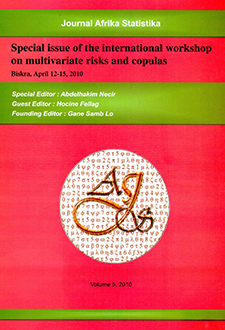Abstract
Insurance of chronic illness is slowly gaining ground in Kenya which has lead to insurance firms introducing insurance products of chronic illness among them being cancer insurance policies. However, unlike other chronic illnesses, cancer can move from the organ of origin to another which will consequently lead to increased cost of treatment. This can not be modeled using ordinary distributions hence it has become an area of interest for many researchers. Zero-truncated phase type distributions are used to solve this drawback of ordinary distributions as it can in-cooperate these transitions while modeling claim count data. They further improve modeling of claim count data as they only consider positive values of claim count excluding zeros. This is the nature of real claim count data as zero claim frequency can not attract any claim severity amount. In this paper aggregate claim losses of secondary cancers in Kenya are estimated using Zero-truncated Poisson Lindley distributions. Zero-truncated one parameter as well as Zero-truncated two parameter Poisson Lindley distributions are derived. Their compound probability generating functions are also constructed. The transitions states of secondary cancer states are estimated using continuous Chapman Kolmogorov equation and used as the matrix parameters for the claim count distributions. Pareto, Generalized Pareto, Weibull, OPPL and TPPL distributions are the distributions considered in this research in modeling claim numbers. This study concludes that aggregate losses of secondary cancer cases using Kenyan data are best modeled by PH-ZTOPPL Generalized Pareto model for PH-ZTOPPL distribution models while for PH-ZTTPPL distribution models the best model was PH-ZTTPPL-Generalized Pareto model. The two best models were compared and PH-ZTTPPL-Generalized Pareto model was proven to be the best model. Comparing this model with PH-TPPL Generalized Pareto model from earlier research PH-TPPL Generalized Pareto model proved to be a better model implying that zero claim count data should be considered in estimation of aggregate losses.
L'assurance des maladies chroniques dont le cancer gagne du terrain au Kenya peu à peu. Ce pendant le traitement de ces maladies, pouvant entrainer des changements d'organes humains, tend à coûter plus cher, et en conséquence, à augmenter les primes d'assurance notablement. La modélisation de ces primes ne peut plus se faire avec des distributions ordinaires. Les méthodes utilisant des distributons zero-tronquées sont utilisées en particulier. Dans ce papier, elles sont utilisées en rapport avec des distributions Pareto, Weibul etc. Nous procédons à une comparaison de ces distributions et en proposons deux qui sont les meilleures.
Citation
Cynthia Mwende Mwau. Patrick Guge Weke. Davis Ntwiga Bundi. Joseph Makoteku Ottieno. "Phase Type Zero Truncated Poisson Lindley Distributions and their application in modeling Secondary Cancer Cases." Afr. Stat. 17 (1) 3145 - 3163, January 2022. https://doi.org/10.16929/as/2022.3145.199
Information





